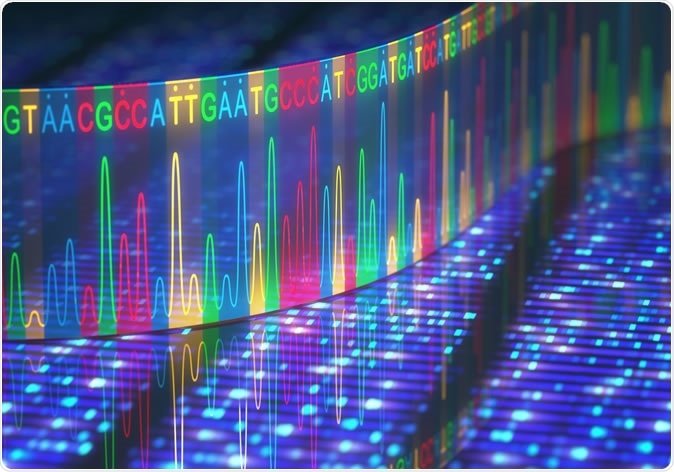Scientists have come up with a new discovery that could transform our understanding of how childhood growth and development are measured – the DNA clock. The study, published in the Proceedings of the National Academy of Science, is the first paper to discuss a precise and non-invasive age measurement tool based on epigenetic DNA changes, designed especially for children. Called the Pediatric Buccal Epigenetic (PedBE) clock, it can tell scientists exactly how old a child’s DNA is. This could also help diagnose serious disorders of development such as autism early enough to make a significant difference.

Image Credit: Ktsdesign / Shutterstock
DNA epigenetics
With epigenetic changes, molecular groups are attached outside the basic structure of the DNA double helix. While these do not alter the fundamental protein-encoding sequence of nucleotides that makes up DNA, they do cause significant changes in the way these proteins are expressed by the genes involved.
Some epigenetic changes occur with age, but others occur as the individual is exposed to pollution, alcohol, certain foods, or other environmental factors. In adults, epigenetic DNA methylation – the number and position of methyl groups on the DNA – have been well studied and provide an accurate diagnosis of a person’s age in biological terms. For instance, the widely used pan-tissue Horvath DNA methylation clock based on methylation patterns at 363 CpG sites, studied in over 8,000 samples from a range of 51 different healthy tissues, predicts adult age quite accurately. If there is a significant difference between the epigenetic age and the actual chronological age, it indicates an important marker of poor health outcomes such as aging-related disorders and an increased risk of earlier death.
However, says researcher Michael Kobor, “Until now we didn't have a tool that was specific for children. These DNA changes occur at very different rates in kids and so we adapted this technique for younger ages.”
The PedBE clock
To deal with this deficit, the team took DNA from cheek cells, obtained by a simple swab, from over 1,000 healthy children, aged from a few weeks to 20 years old. They tested for DNA methylation at 94 different CpG sites that are peculiar to cheek cells. At these locations, methylation occurred at predictable times over a child’s growth span, helping them to narrow down the child’s age to within four months. In contrast, the Horvath clock has a variation of about 1.7 years.
The advantages of using cheek cells include the ease of collection, relative uniformity of the cell sample, and the stability of the DNA methylation changes.
The PedBE clock showed accurate increases in biological age when repeated with samples taken later in life from the same babies. The greatest accuracy was observed with young children, and the variation was slightly more in late adolescence samples, perhaps because of the changing rate of DNA methylation at this time.
Interestingly, the scientists found that babies delivered later in pregnancy showed a faster rate of DNA changes by the time they were around 3 months old, indicating the utility of this tool in assessing an infant’s real developmental age. This is very important in finding out the reasons why a child is apparently showing delayed development, and may indicate a link between brain maturation and DNA methylation, though not with birth weight.
Implications
Researcher Lisa McEwen says, “This powerful and easy-to-use tool could be used by clinicians to identify why some children aren't meeting early milestones and potentially diagnose children with developmental disorders earlier in life. This would enable doctors and pediatricians to intervene sooner in a child's life leading to better outcomes for kids.”
To test their concept, the scientists tried out the PedBE clock on a small group of children, and found that with some kids who had autism spectrum disorder (ASD), the clock showed they were developmentally older compared to neurotypical children. This could suggest a possible direction for future research to screen for ASD using this tool, which has “powerful potential” according to Kobor.
The researchers have published the tool online with their study, in the hope and expectation that it will be used freely for experiments from day one.
Journal reference:
The PedBE clock accurately estimates DNA methylation age in pediatric buccal cells. Lisa M. McEwen, Kieran J. O’Donnell, Megan G. McGill, Rachel D. Edgar, Meaghan J. Jones, Julia L. MacIsaac, David Tse Shen Lin, Katia Ramadori, Alexander Morin, Nicole Gladish, Elika Garg, Eva Unternaehrer, Irina Pokhvisneva, Neerja Karnani, Michelle Z. L. Kee, Torsten Klengel, Nancy E. Adler, Ronald G. Barr, Nicole Letourneau, Gerald F. Giesbrecht, James N. Reynolds, Darina Czamara, Jeffrey M. Armstrong, Marilyn J. Essex, Carolina de Weerth, Roseriet Beijers, Marieke S. Tollenaar, Bekh Bradley, Tanja Jovanovic, Kerry J. Ressler, Meir Steiner, Sonja Entringer, Pathik D. Wadhwa, Claudia Buss, Nicole R. Bush, Elisabeth B. Binder, W. Thomas Boyce, Michael J. Meaney, Steve Horvath, and Michael S. Kobor. PNAS October 14, 2019. https://doi.org/10.1073/pnas.1820843116. https://www.pnas.org/content/early/2019/10/09/1820843116